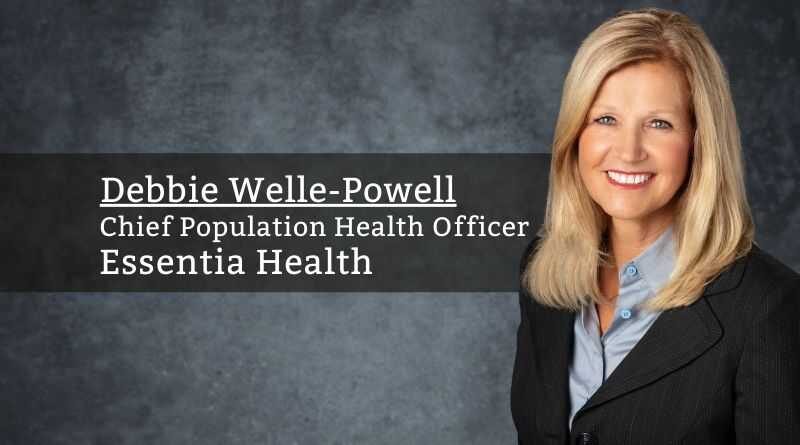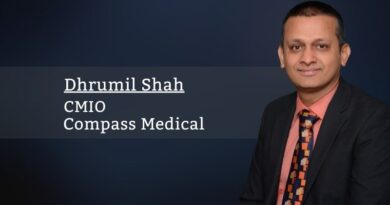The Future of Integrated Virtual Care…
It’s not as far off as it seems. In fact, it’s at your fingertips.
By Debbie Welle-Powell, Chief Population Health Officer, Essentia Health
Digital Care is here to stay.
The COVID-19 pandemic accelerated change to a new model of care; a virtual (digital) model built to deliver care at the right time, all in the comfort of the patient’s home.
Health care systems, including Essentia Health, were challenged by the pandemic to deliver necessary care differently. Prior to COVID, we offered limited retail E-Visits and remote patient monitoring (RPM) only to high acuity chronic heart failure patients. When the pandemic hit, we took a quantum leap forward, resourced our change management capability and fast-tracked the adoption of digital technology. With the technology platform in place (built), we were able to move quickly to direct-to-consumer services that kept our patients safely in their homes. This technology also kept our providers and staff safe by limiting the number of patients on campus and reducing viral transmission in the community. Today our direct-to-consumer digital programming includes on-demand video visits, retail E-Visits, RPM, and our newly approved CMS Hospital at Home waiver program.
A shift in mindset is occurring with our clinicians. They are trusting the technology to deliver timely and safe care.
This new model of care is generating higher patient satisfaction scores, showing we are truly improving the patients’ experience.
Essentia Health’s Story and the Impact of Virtual Care
- The Numbers. Essentia led other health systems in Minnesota with well over 604,000 telehealth visits since the pandemic started. Our expanded RPM Program prevented 102 hospital admissions and prevented 67 emergency department visits. This work generated savings of approximately $2.5 M across Medicare, Medicaid and commercial populations. Essentia holds thirteen total cost of care contract agreements totaling 180,000 at-risk lives. When we appropriately reduce utilization, these earnings are reinvested in chronic care programs, enhanced technology applications and analytical tools. Negotiating value-based, risk contracts has been a key to our success as an integrated health system and Level 3 NCQA Accredited ACO because we are able to measure the impact of closing gaps in care and quantify making health care more affordable.
- Screening Social Determinants of Health (SDOH) and Social Needs. The COVID-19 pandemic placed a great deal of strain on our communities. At the beginning of 2020, we were just piloting a social needs screening program asking our patients about food insecurity, transportation and financial strain. In April 2020, we rapidly scaled up social needs screening to ensure our 75 primary care and pediatric clinics were offering this screening to all of our patients. To date, we’ve offered this screening to more than one million patients, with 46% (420,330) of patients responding. We found that a significant increase in requests for social needs (particularly food) was reported. As a result, more community health workers were hired, and our relationships with community partners were expanded. We’ve been able to successfully connect more than 2,000 patients with the community resources they needed.
In April 2021, building on our work, we launched RESOURCEFUL, a free, online, public resource directory, through a partnership with Aunt Bertha. Its name “RESOURCEFUL,” reflects our desire to bring community assets to our patients. The program makes it easy for patients to identify resources close to them, empowering them to seek needed information to help themselves. We are widely promoting this to our patients and community. The process has truly been collaborative in nature, with our community partner organizations helping us name, brand and promote the site. - Evolving New Care Team. As our care models evolve, so too must the care team. With the successes in implementation and growth of virtual visits and RPM for both COVID and chronic care patients, we recently approved a permanent Essentia 24/7 Telehealth Care Team. It is essentially backup to primary care services, however, performed remotely with digital technology. Now, on a 24/7 basis, we provide on-demand care to our patients, along with annual wellness visits and advance care planning. A shift in mindset is occurring with our clinicians. They are trusting the technology to deliver timely and safe care. With RPM devices, we are seeing our emergency medicine physicians, cardiologists, and hospitalist coming to us and asking if we can deploy the devices in the patient’s home. RPM is becoming a standard of care for patients with conditions such as diabetes, enabling them to manage their diet and blood sugar levels with wearable push/pull devices.
Our hospitalists, paramedics, pharmacists, social workers, and nurses are developing clinical competencies to provide care in a different environment with our hospital-at-home program. We can see that the care team of the future is going to be heavily influenced by digital technology and the data it produces. Care team members must have skills on how to integrate technology and data into their care of the patient, and we must expand our definition of the “Team”, as we will see the patient and his/her devices become more of an active member in the plan of care, in this virtual world.
The Challenges of Virtual Care. There are still many challenges and barriers with telehealth to overcome. From parity in reimbursement, and state licensure, to the technological challenge of broadband connectivity and integrity, we must assume the virtual/digital care model will continue to evolve. There is also the need to cut through the noise and distractions, help make the data timely and more meaningful, and provide ongoing education to our clinicians. In addition, there are new, non-traditional stakeholders in the health care ecosystems too, such as regulators, financiers and intermediaries who will shape the future. As is the constant, this too will change.
In Summary
The disruptive nature of the COVID pandemic forced us to re-think the care delivery model and optimize the digital and virtual delivery system. It continues to force us to evolve, to adopt and to expand upon the new care model. Consumers are increasingly willing to share their personal data through “wearable” technology and bluetooth-enabled devices. Additionally, this new virtual model of care is empowering consumers to take control of their well-being in ways that were impossible just a few short months ago. Health systems and clinicians with deep roots in care delivery must ask themselves how to best use this new technology, and its data, to transform what well-being and virtual care delivery means in the future. The future is not as far off as it seems. In fact, it’s at your very finger tips.



